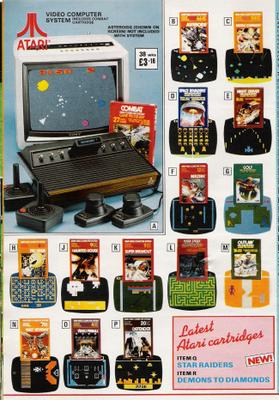 From a spring/summer 1983 mail order catalogue. The Atari video system cost £119.99 - very expensive back then. The blurb read: Connect it to your TV in seconds - sit back - and get ready for a new experience! Every system includes console, two joy stick controllers, mains adaptor and 27-game combat cartridge. There's action, adventure, excitement. Pit your wits - against the computer or up to three opponents. On-screen scoring, different levels of difficulty, realistic sound effects... start sharing in the fun now!
From a spring/summer 1983 mail order catalogue. The Atari video system cost £119.99 - very expensive back then. The blurb read: Connect it to your TV in seconds - sit back - and get ready for a new experience! Every system includes console, two joy stick controllers, mains adaptor and 27-game combat cartridge. There's action, adventure, excitement. Pit your wits - against the computer or up to three opponents. On-screen scoring, different levels of difficulty, realistic sound effects... start sharing in the fun now!
The TV games, including Space Invaders, Pac-Man, Asteroids and Haunted House, cost from £15.99 to £31.99.
 Crumbs - the little darling at the top of this catalogue page cost £599.95. So, what did you get if you could afford it? The blurb, maestro, please!
Crumbs - the little darling at the top of this catalogue page cost £599.95. So, what did you get if you could afford it? The blurb, maestro, please!
Flexible system expansion and varied programme applications; 48K byte dynamic RAM; employs BASIC in the tape mode; PASCAL software system also available simply by replacing tapes; 9-inch high focus monochromatic display - 25 lines, 40 characters wide; advanced functions include scrolling display rolling and screen editing; typewriter keyboard arrangement with numeric keypad to make data entry smooth and operation simple; built in clock circuit; complete with four programmed cassettes covering BASIC editorial, Home Finance, Educational and Games.
And in simpler terms?
Sharp computer, designed for home and office environment. Applications include stock management, invoicing, marketing analysis, maths, physics, chemistry, computer linguistics, data analysis, home budget management, games etc.
 Double page advertisement from 1984 for the Commodore 16 complete starter pack - Everything you need To start computing in one box.
Double page advertisement from 1984 for the Commodore 16 complete starter pack - Everything you need To start computing in one box. Some computers and games featured in the Janet Frazer autumn and winter 1984/5 mail order catalogue.
Some computers and games featured in the Janet Frazer autumn and winter 1984/5 mail order catalogue.  Fun with the likes of Zaxxon and Sensor Travel Chess. The Tomy Skyfighters "brings you realistic sights and sounds. Press the top control buttons to manoeuvre your 'Skyfighters' against the enemy squadron."
Fun with the likes of Zaxxon and Sensor Travel Chess. The Tomy Skyfighters "brings you realistic sights and sounds. Press the top control buttons to manoeuvre your 'Skyfighters' against the enemy squadron." The Atari 600XL and the Commodore 64.
The Atari 600XL and the Commodore 64. Games for the Commodore 64, Sinclair Spectrum 48K and Atari 600XL and 400/800.
Games for the Commodore 64, Sinclair Spectrum 48K and Atari 600XL and 400/800. The new streamlined-look Atari 2600 console and games galore - including the delectable Ms Pacman.
The new streamlined-look Atari 2600 console and games galore - including the delectable Ms Pacman. Goodies here include the Philips Videopac G7000, a "boss joystick" suitable for Atari 2600 video game, Atari computers, Commodore 64 and Vic 20 computers, and lots of lovely games like Donkey Kong and Zaxxon.
Goodies here include the Philips Videopac G7000, a "boss joystick" suitable for Atari 2600 video game, Atari computers, Commodore 64 and Vic 20 computers, and lots of lovely games like Donkey Kong and Zaxxon.























































